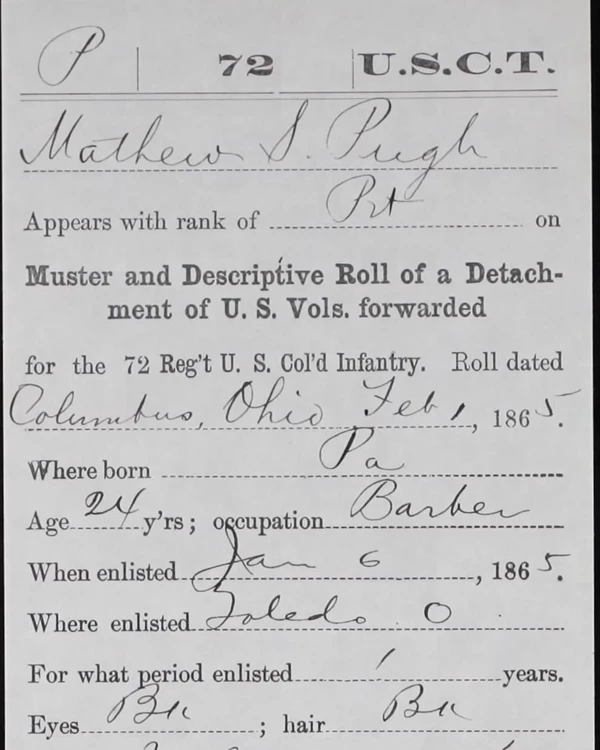Last updated: March 20, 2024
Person
Matthew S. Pugh

National Archives
Pre-War
Matthew Pugh was born on August 13, 1840, in Wrightsville, York County, Pennsylvania. According to the 1850 census, Mathew (age 8) was living with his parents, Benjamin (age 45) and Elizabeth (age 48), Rebecca Silleston (age 21) and Pugh's 75-year-old grandmother, Mary Schooley. Sometime before 1860, Mathew and his parents packed up and moved 200 miles north to Elmira, New York. Here as a young, single man, Mathew Pugh was educated, employed as a barber, and frequently traveled between Wrightsville, PA, Columbia, PA, Elmira, NY, and Washington, D.C.
Civil War
Pugh was drafted on June 10, 1863, in Columbia Borough, Lancaster County, Pennsylvania, but he never reported for duty. Two days after this call to service, on June 12, 1863, Pugh married 19-year-old Henrietta Sweeney, whose family lived just across the river from him.Two years later, Pugh enlisted in the U.S. Army and was mustered in on January 6, 1865, in Toledo, Ohio, marking his official entry into service. He was then sent to Camp Henry, Kentucky, where he served alongside Tennesseans, Kentuckians, and Ohioans as a private in Company D of the 72nd United States Colored Infantry [USCI]. Pugh was promoted to sergeant on February 19, 1865, shortly before the 72nd USCI was consolidated that spring. Upon the 72nd being disbanded, Pugh joined company M of the 12th United States Colored Heavy Artillery [USCHA]. He was promoted to quartermaster sergeant on October 10, 1865, and was honorably discharged on January 29, 1866.
Post-War Life
After the Civil War, Pugh resumed his career as a barber and, with his wife Henrietta, had 11 children while living in several different Pennsylvania counties. However, after his discharge in 1866, he began experiencing vision problems, and by his forties, Pugh’s vision deteriorated to the point where he was unable to support his family. As a result, he filed an application for an invalid pension from the US government on March 3, 1880. In his pension documents, Pugh stated that he “caught a cold in his eye while sleeping on the cold ground in camp in February.” This was a plausible assumption, given the difficulties of living in tents amid winter conditions. He was seen by Dr. Twichel at Camp Nelson but was later unable to obtain an affidavit from either Dr. Twichel or his assistant. After consulting with three additional doctors, oculist Dr. S. Lapman finally declared, in 1906, that Pugh was blind in his right eye and had severe cataracts in his left eye, allowing the USCT veteran to finally receive a pension. Pugh’s failing eyesight greatly hindered him, and when Henrietta passed away at the age of 48, the family needed assistance. Fortunately, Henrietta’s niece, Mary Millburn, took care of Pugh’s younger children and later cared for him as his eyesight continued to deteriorate. Millburn took care of Pugh for thirty-seven years before his death on March 4, 1929. Pugh received all requests for pension increases and spent his final years receiving support from family and friends.
Dispite his difficulty seeing, Pugh was an active member of the Grand Army of the Republic at Post # 369, in Wilkes Barre, PA. At one point, in 1884, he served as the adjutant under Commander and Reverand John H. Hector for a lecture held at the National Hall discussing Hector's life story.
